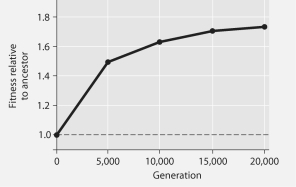The following questions refer to Figure 27.1 below, which is the same as Figure 27.10 in the textbook.
In this 8-year experiment, 12 populations of E. coli, each begun from a single cell, were grown in low-glucose conditions for 20,000 generations. Each culture was introduced to fresh growth medium every 24 hours. Occasionally, samples were removed from the populations, and their fitness in low-glucose conditions was tested against that of members sampled from the ancestral (common ancestor) E. coli population.

Figure 27.1
-If the experimental population of E. coli lacks an F factor or F plasmid, and if bacteriophage are excluded from the bacterial cultures, then which of these is a means by which beneficial mutations might be transmitted horizontally to other E. coli cells?
Definitions:
Collaborative Project
An endeavor undertaken by two or more individuals or groups working together towards a common objective or goal.
Writing Steps
The stages involved in producing a written document, typically including planning, drafting, revising, and editing.
Organize the Material
The process of arranging or structuring information and resources in a logical, easy-to-follow manner for effective presentation or use.
Collaborative Writing
The collective process of creating a document or content with multiple contributors or authors.
Q8: If all prokaryotes on Earth suddenly vanished,
Q15: Which of the following is True of
Q22: Sequencing an entire genome, such as that
Q31: Test tube 2 contains<br>A)Paramecium<br>B)Navicula (diatom)<br>C)Pfiesteria (dinoflagellate)<br>D)Entamoeba<br>E)Plasmodium
Q32: What is it about short tandem repeat
Q42: Which of these is the smallest unit
Q61: Assuming that they all belong to the
Q61: Which structure is common to both gymnosperms
Q67: If there are 4,000 children born to
Q73: Which of these factors, when used to